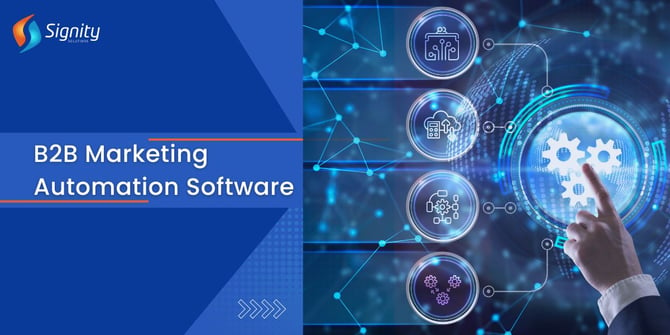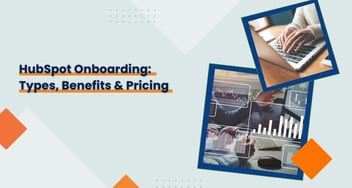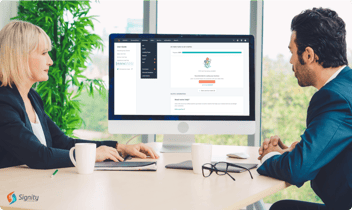What Is the Best B2B Marketing Automation Software?
Discover the transformative impact of B2B marketing automation with tools like HubSpot. Signity Solutions plays a key role, reshaping digital business interactions. Learn its rise, benefits, and top software choices for 2023.

Imagine you're a business owner, and every morning you spend hours manually sending out emails to potential clients, tracking their responses, and categorizing leads based on their interest levels. Imagine a tool like Hubspot Marketing Automation that automatically does all these tasks, giving you more time to focus on strategic decisions and nurturing relationships.
This is the transformative power of B2B marketing automation software. It's not just about automating tasks; it's about enhancing efficiency, improving accuracy, and driving business growth with the help of Marketing Automation Tools.
Enter Signity Solutions, not just as a commentator but as a critical player in the B2B marketing automation arena. With their cutting-edge software, they are reshaping the way businesses interact with each other in the digital domain. Their expertise is in understanding the importance of automation and providing a solution that embodies it.
As we journey through this topic, we'll uncover the intricacies of B2B marketing automation and why industry leaders like Signity Solutions are at the forefront of this revolution. But first, let's take a step back in time to understand how B2B marketing automation began its ascent, setting the stage for "The Rise of B2B Marketing Automation.”
The Rise of B2B Marketing Automation
Years ago, businesses talked to each other in person, made phone calls, and wrote letters. When computers became popular, they started using emails and online ads. But people still did a lot of the work manually.
Then came the game-changer: marketing automation. In the late 1990s and early 2000s, software developers began creating tools like HubSpot CMS that could automate repetitive marketing tasks. These tools allowed businesses to send out emails in bulk, track customer behavior, and analyze campaign results without constant manual oversight.
The evolution didn't stop there. As technology continued to advance, these tools became smarter, more integrated, and more essential to a company's marketing strategy.
Now, let's focus on the B2B sector. Unlike business-to-consumer (B2C) companies, businesses in the B2B sector have a unique challenge They talk to more people, wait longer to make a sale, and often sell complicated things.
This is where the new software really helped. It let B2B companies talk to potential customers over a long time, change their messages based on what a person did, and use facts to make choices. Today, with the help of Hubspot CRM Features, this software helps B2B companies work better and faster.
As we move forward, it's clear that the rise of B2B marketing automation is not just a trend but a fundamental shift in how businesses operate and succeed in the digital age.
Now that we've seen how B2B marketing automation came to be, let's dive into its key features and understand what makes it so powerful.
Key Features of an Ideal B2B Marketing Automation Software
In today's digital age, businesses need good tools to succeed. B2B eCommerce marketing automation software gives them these tools. These aren't just fancy extras; they're important tools that help businesses reach out, connect, and grow.
- Lead Management and Scoring:
This tool helps businesses watch and rate potential customers. It scores them based on their interest. A high score means they might buy something.
- Email Marketing Automation:
This tool lets businesses send many emails quickly. If someone clicks a link, it sends another email. It ensures the right emails go to the right people.
Another example of email automation would be sharing digital business card with the prospects. As soon as the customer clicks the card, they access the vital company's information, services, etc.
- Campaign Management:
This is a central place for all marketing tasks. Businesses can set up, run, and review their marketing here. It shows them what's working and what's not.
- Analytics and Reporting:
This feature shows businesses how well they're doing. It gives them numbers and charts about their marketing. They can see which emails people open, which ads they click on, and more.
With these features in hand, businesses are better equipped to navigate the challenges of the B2B landscape. But the story doesn't end here. Let's move on to explore the tangible benefits these features bring in the section "Benefits of Implementing Marketing Automation."
Benefits of Implementing Marketing Automation
In the modern business world, staying ahead means working smarter, not just harder. Marketing automation is like a helpful assistant, making tasks easier and results better. From taking care of potential customers to making informed decisions, it offers a range of benefits. Let's dive into them.
- Enhanced Lead Nurturing:
Marketing automation helps businesses take care of potential customers. It sends them information and offers at the right time. This makes potential customers more likely to buy.
- Improved Efficiency and Productivity:
With automation, businesses can do more in less time. They don't waste time on small tasks because the software does it for them. This lets them focus on bigger things.
- Personalized Customer Experiences:
The software knows what each customer likes. So it can send them messages and offers that they care about. This makes customers feel special and understood.
- Data-Driven Decision-Making:
Marketing automation gives businesses clear data. They can see what's working and what's not. This helps them make smart choices based on facts.
As we've seen, the advantages of marketing automation are clear and impactful. But to truly harness its power, choosing the right software is crucial. Let's journey ahead and explore the top B2B marketing automation software options in 2023.
Top B2B Marketing Automation Software in 2023
Navigating the world of B2B marketing in 2023 requires the right tools. Let's dive into the top marketing automation software options that are shaping the industry this year.
1. Signity Solutions:
Benefits:
- Simple Design: Signity Solutions has a clear and straightforward layout. Even newcomers find it easy to use.
- Everything in One Place: From sending emails to checking data, Signity Solutions offers all tools together. This makes marketing tasks flow smoothly.
- Custom Settings: Every business is different. Signity Solutions lets you change settings to fit your company's needs.
Challenges:
- First-Time Use: It's packed with features to address any business challenge, so new users may need a while to familiarize themselves with it.
- Pricing: High-quality tools come at a price. Some businesses might find it a bit on the higher side.
2. AutoMark Pro:
Benefits:
- Automate Repetitive Tasks: AutoMark Pro takes over tasks you do again and again, saving you time.
- Detailed Customer Insights: It gives you deep reports, showing what your customers like and do.
Challenges:
- Combining with Other Tools: If you use other software, integrating them with AutoMark Pro can be a challenge.
- Waiting for Support: Sometimes, their support team takes a bit longer to respond.
3. BizBoost 360:
Benefits:
- Rate Potential Customers: This feature exceptionally examines and scores potential customers, showing who might buy from you.
- Professional Email Designs: They offer a variety of email templates, so you don't have to start from scratch.
Challenges:
- Learning All Features: With so many tools, some users might feel there's a lot to learn.
- Keeping Up with Updates: They add new features often, so users need to stay updated.
4. HubSpot:
Benefits:
- Comprehensive Toolkit: HubSpot offers a full suite of tools, from email marketing to CRM, all integrated seamlessly.
- User-Friendly Interface: Its intuitive design ensures even beginners can navigate and utilize its features effectively.
- In-depth Analytics: HubSpot provides detailed insights into customer behaviour, helping businesses tailor their strategies.
- Educational Resources: With a vast library of tutorials, webinars, and articles, users can continually learn and optimize their marketing efforts.
Challenges:
- Pricing Tiers: While HubSpot offers a free version, advanced features come at a higher price, which might not fit all budgets.
Related Read: HubSpot Free vs Paid: Which Plan is Best For You?
- Integration with External Tools: While it integrates well with many tools, some niche or specialized software might require custom solutions.
- Complexity: With its wide range of features, new users might feel overwhelmed and need time to explore all functionalities.
5. SalesSyncer:
Benefits:
- Connects Sales and Marketing: It brings your sales and marketing teams together, making processes smoother.
- Access Everywhere: It's online, so you can use it whether you're in your office or on vacation.
Challenges:
- Needs Good Internet: A strong internet connection is a must to use it.
- Online Data Concerns: Some businesses might worry about keeping their data on the internet.
6. FreJun:
Benefits:
- Call Automation: FreJun automates calling and logs your business calls and insights with your favorite workflow tools in a single click.
- Autodial: Eliminate manual dialing and make more calls with click-to-call and autodial features. All calls are recorded and logged automatically for future reference and training.
- Improve Call Pickups: Enhance call pickups with Truecaller on your FreJun virtual number, avoiding spam listings and establishing trust.
- Analytics and Performance Tracking: FreJun’s analytics helps track team performance, identify effective processes, and improve productivity.
- Integration: Simplifies your business calls by integrating FreJun with your existing workflow tools, keeping all your call data organized in one place.
Challenges:
- Needs Good Internet: Requires a stable internet connection for optimal performance.
- Online Data Concerns: Businesses may have concerns about data security when storing information online.
In 2023, these are the top choices for B2B marketing automation software. Each one has its strengths and areas to improve. Choosing the right one can help a business grow and succeed. Let's continue to learn more about making the best choice for your business.
Tips on How to Choose the Right Software for Specific Business Needs
Choosing the right software for your business can feel like navigating a maze. But by focusing on specific criteria, you can find a solution that fits like a glove.
- Know Your Needs: List what you want before looking at options. Do you need better emails, clear analytics, or better lead management? This list helps you make the right choice.
- Set Your Budget: Decide how much to spend. While many price options exist, pick one that offers good value for its cost.
- Pick Easy-to-Use Software: Software might be packed with features, but if it's too complicated, it won't be beneficial. Look for software that has a user-friendly interface and offers training or tutorials.
- Check for Integration: Make sure the software works well with tools you already use, like HubSpot CRM Features or email platforms.
- Ensure It Grows with You: Your needs will change as your business grows. Pick software that lets you add features or manage more data over time.
Remember, the best software not only meets your current needs but also adapts to future challenges. Make a choice that sets your business up for long-term success.
Final thoughts
In our rapidly evolving digital age, the tools we choose can either propel us forward or hold us back. The right software isn't just about features or price; it's about alignment with our vision and goals.
As businesses, we must ask ourselves: Does our chosen tool pave the way for growth, or does it merely check a box? The decisions we make today lay the foundation for our future. It's not just about surviving in the market but thriving and leading.
So, as we stand at the crossroads of choice, let's not just seek convenience. Let's aim for transformation, for tools like HubSpot CMS and Signity Solutions that don't just serve our needs but amplify our potential.
The future is not just something we step into; it's something we shape. Choose wisely.


%201-1.webp)


.png?width=344&height=101&name=Mask%20group%20(5).png)
















